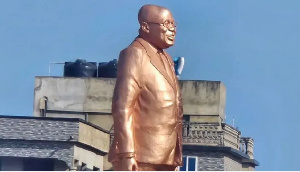Opinions of Thursday, 25 June 2020
Columnist: Daniel Korang
Mandatory wearing of face mask in public places: Is a private car a ‘public place’?
The outbreak of the Covid-19 pandemic has compelled the Government of Ghana to use legal means to impose restrictions and other measures to curb the spread of the virus.
The government’s first legal means to control the spread of the pandemic was the enactment of The Imposition of Restrictions Act, 2020 (Act 1012). Following this Act, the government has made some Executive Instruments (EIs) to impose specific restrictions and measures to achieve the purpose of Act 1012.
The most recent EI is the Imposition of Restrictions (Coronavirus Disease (Covid-19) Pandemic (No. 10) Instrument, 2020 (E.I. 164). From the fourth (4th) Recital to E.I. 164, the purpose is to make the wearing of face coverings outside places of abode a mandatory requirement for all persons.
Regulation 1 of E.I. 164 requires a person to wear a face mask, face shield or any other face covering that covers the nose and mouth completely when that person is in a public place or leaving or returning to his place of abode.
Observably, the E.I. fails to define “Pubic Place”. Clear as this provision seems to be, the meaning of the words “Public Place” in the regulation has been a subject of public discussion. Particularly, it has been hotly debated whether a private car is a public place within the intendment of the law. This article offers some guide to answer the question.
Interpretation according to purpose of the law
It is a cardinal principle that penal legislation must be interpreted to give effect to the purpose of the law. Section 4(b) of Criminal Offences Act, 1960 (Act 29) requires that the provisions of the Act should be construed amply and beneficially to give effect to the purposes thereof. As for all issues of statutory interpretation, the basic question is what the lawmaker intended, and that intention is discovered by looking at the words of the provision, informed by its history, context and purpose. It is elementary to say that the courts must discern and apply the legislative intent when construing criminal statutes. And that intent must be found upon an examination of the words employed in the enactment.
The broad aim of criminal law is to prevent harm to society and its members, and the interpretation of criminal statutes must further this aim. A cardinal principle of statutory interpretation is that words ought to be given their ordinary meaning in harmony with the goal of the legislation. A criminal statute should be accorded a sensible construction. This means construction must accord with the purpose of the statute and avoid absurd results. Where broad words are used in a criminal statute, it is proper to construe those words so as not to cause absurdity.
The temptation for the court to explain broad words to cover unspecified acts is real, but such temptation must be resisted. In interpreting a provision couched in broad words, the appropriate guide is to look beyond the naked text for guidance when the result it apparently decrees is difficult to fathom or where it seems inconsistent with parliamentary intention. Penal statutes must not be made to reach beyond their plain intent; they include only those acts coming clearly within the import of their language.
Indeed, constructive crimes, i.e. crimes created by courts with the aid of inference, implication, and strained interpretation, are repugnant to the spirit and letter of the criminal law. It is not permissible in the construction of criminal statutes for the courts to go so far as to create an offense by enlarging a statute, by inserting or deleting words, or by giving the words false or unusual meanings.
Under section 1 of Act 1012, the purpose of the law is to impose restrictions on persons to ensure public safety, public health and protection. It is in furtherance of this objective of the law that E.I. 164 was made. From a critical look at the provisions of the law, it would appear that the overriding purpose of the law is to ensure public health and safety by curbing the spread of the Covid-19 Pandemic. Any acceptable interpretation of the provisions of E.I. 164 must be one that furthers the legislative intent of the law. This accords with the principle of interpretation known as Modern Purposive Approach. The meaning of the term “Public Place” should not be strained to include places which do not have any bearing on the purpose of the law.
Meaning of ‘public place’ under E.I. 164
It must be said that neither Act 1012 nor any of the Executive Instruments made thereunder defines the term ‘Public Place’. I propose to refer to certain Acts of Parliament which define the term “Public Place”.
Act 29 defines ‘public place’ under section 1, to include “any public way and any building, place, or conveyance to which for the time being the public are entitled or permitted to have access, either without any condition or upon the condition of making any payment, and any building or place which is for the time being used for any public or religious meeting or assembly, or as an open Court”.
‘Public Place’ is also defined under section 10 of the Public Order Act, 1994 (Act 491) to mean “a place to which, at the material time, the public have or are permitted to have access whether on payment or otherwise”.
Regulation 16 of the Breastfeeding Promotion Regulations, 2000 (LI 1667) defines ‘public place’ to mean “a place to which, the public have or are permitted to have access whether on payment or otherwise”.
Section 72 of The Gaming Act, 2006 (Act 721) defines ‘public place’ as “an area which is generally accessible to all manner of persons”.
The Copyright Act, 2005 (Act 690) is more specific in its definition of ‘public place’. Section 76 defines public place as “any building, place or conveyance to which for the time being the public are entitled or permitted to have access, either without any condition or upon condition of making any payment, and includes theatres, hotels, cinemas, concert halls, dance halls, bars, clubs, sports grounds, holiday resorts, circuses, restaurants and commercial banking and industrial establishments.”
It must be stressed that the definitions of public place in the various Acts do not have general application to all criminal offences; they apply to specific criminal offences created under those Acts. It will therefore be wrong for anyone to define “public place” as used in E.I. 164 by reference to any of the above definitions. Those definitions may only be used as guide. It would appear that the overriding consideration in determining whether or not a place is a “public place” is whether the public have access to the place as of right or on payment of money.
For the purpose of the mandatory wearing of face masks, a commercial vehicle or public transport is a public place as the public have access to it on payment of money. This cannot be said of a private car. It is true that the public do not have access to private vehicles as a matter of right or on payment of money. As has been emphasized earlier, the term “public place” for the purpose of E.I. 164 must be carefully construed to attack the particular evil at which that law is directed. What is that evil? That evil is to curb the spread of the Covid 19 pandemic. It is submitted that the exclusion of private cars from the definition of the public place will not defeat the purpose of the law. This essay fails to see how a person in his private car alone can cause or exacerbate the spread of coronavirus without wearing face mask.
The unimpeachable import of “public place” under E.I. 164 is that there must be the possibility of making contact with members of the public if social distancing is not observed. This cannot happen in a private car.
Under E.I.164, a private car is not a public place. Any attempt to reach a contrary interpretation will render the law both arbitrary and overbroad. A law that imposes limits on the interests and liberties of the individual in a way that bears no connection to the law’s objective is arbitrary. Overbroad deals with a law that is so broad in scope that it includes some conduct that bears no relation to the law’s purpose.
To require a person travelling in his private car from Accra to Kumasi to wear a face-covering is completely out of sync with the purpose of the law. The question is: can that person infect anyone with coronavirus if he is infected? Put differently, to what extent does that person endanger members of the public by his failure to wear a face mask? The analysis of the question must involve a consideration of the effect a failure to wear a face mask will have on member of the public.
Because the term “public place” has not been defined in E.I. 164, it is necessary to interpret and apply the law in a manner that comports with its purpose. Since the rationale of the law is to ensure public health and safety by curbing the spread of the coronavirus, it would be incongruous to say that the interior of a private car is a public place. A private car is not meant for the public. The public does not have access to the interior of a private car as of right. Given that private cars are not used for carrying passengers, the lawmaker did not intend private cars to be regarded as public places. The interior of a person’s private car can be said to be an extension of that person’s private place of abode.
No one can forcibly enter a person’s private car without necessarily violating the person’s privacy. The fact that police officers often draw close to drivers of private cars on the highways does not make private cars public places. Once the person remains in the car, he is not worse off than the person who peeps to talk to his neither through the window of his bedroom. None is required to wear nose mask.
Conclusion
My review of E.I. 164, including its purpose and background, persuades me that, contrary to the strict and rather absurd arguments by some police officers, a private car on the street or highway cannot logically be considered as a public place. A public place must be freely accessible to the public. It is difficult to appreciate the view that a public place includes a private car for the purpose of controlling the spread of the COVID 19.
A person in his private car may carry a face mask on him to be worn by him when he disembarks in a public place, and not when he is alone in the car. A person does not violate the law where he travels in his private car without having a nose mask on him. He only breaks the law when he gets out of the car without wearing a nose mask. This a sensible interpretation of “public place”. It is submitted that a police officer is wrong to arrest a person who is alone in his private car for failing to wear a face mask. That arrest does not only fail to advance the purpose of E.I. 164, it also constitutes arbitrary enforcement of the law. The law on face mask does not apply to a person inside his private car irrespective of where the car is.
Entertainment










